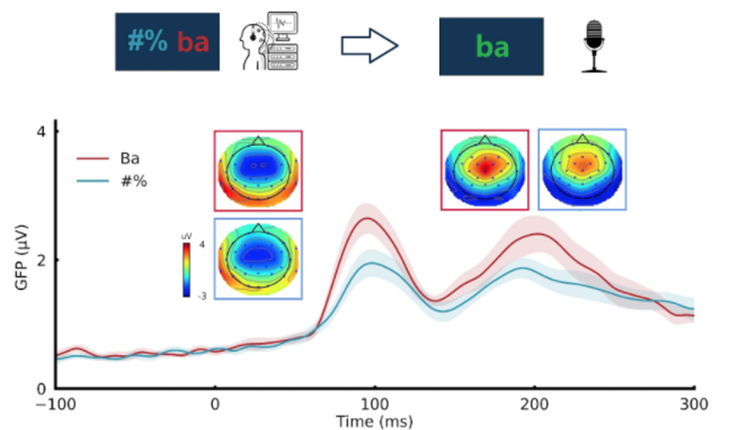How can humans sense the consequences of our actions, while at the same time perceive changes in the environment? A research team led by Assistant Professor of Neural and Cognitive Sciences Tian Xing tackled this question by studying how the way we produce speech affects the way we perceive other sounds in the environment. The findings by Tian and his PhD students at the NYU-ECNU Institute of Brain and Cognitive Science at NYU Shanghai, Zhu Hao and Li Siqi, were published in an article in the neuroscience journal, Cerebral Cortex.
The team’s findings expand our understanding of how speech production may influence sensory perception. “Our research shows that the brain has two different neural signals - one for inducing auditory-like neural activity and another for monitoring the induction process,” said Tian. “Most of us can speak fluently. The induction process may help us prepare the next utterance, whereas the monitoring process may generate predictions and compare them with feedback to check whether the speaking is carried out correctly.”
Tian’s team conducted three experiments with participants from ECNU. In each set of experiments, participants were asked to speak after a preparation stage. They were shown visual cues that either consisted of random symbols, so that they would not know what to say, or one of four syllables, which acted as preparatory content. Toward the end of the preparation stage, an auditory cue of either a tone or one of the four syllables was played. The research team then recorded brain electrical signals and found that after subjects received the auditory cue, the patterns of two neural signals - induction signals and monitoring signals - varied significantly based on whether a subject knew what to say.
The results revealed that the monitoring signal is a generic form of motor signal that can be generated even without preparatory content. On the other hand, motor signals generated when participants received preparation via a linguistic cue enhanced the response to an auditory cue of the same syllable, suggesting that the induction signal carries specific content information. These results indicate that an induction signal helps label the consequences of our actions, while a monitoring signal sensitizes our perception of the environment.

An electroencephalography (EEG) plot from the experiment, showing spikes in brain activity following visual and auditory stimuli
The research also provides important insights into understanding neural and mental disorders such as schizophrenia, and in particular may point to a possible cause of auditory hallucinations. “If the induction process is operational but the monitoring process is impaired, the auditory-like neural activity can be induced without any external stimuli, fail to to be monitored and erroneously attributed to some external sounds. This may cause auditory hallucinations,” said Tian. They will be exploring this possibility in follow-up studies.
This study forms a major part of Li’s dissertation on neural interaction among speech hierarchies. “Speech is a means for transmitting ideas and concepts via producing and receiving sound,” she explained. “This research is a major part of my dissertation because it shows the interaction between speech perception and speech production.”
For Zhu, the co-first author on the paper, this research lays the foundation for his dissertation, which will examine motor-to-sensory transformation in human speech and language. “I see this process as significant training for my research career. I've learned so much from it,” he said. “I'm fortunate to have this amazing opportunity to work with brilliant people like Siqi and Prof. Tian and make a small contribution to the field.”
Tian, Li and Zhu are part of the Speech, Language and Neuroscience Group (SLANG), a research lab in the NYU-ECNU Institute of Brain and Cognitive Science. Li is a ECNU PhD student affiliated with the institute, while Zhu is a student in the NYU Doctoral Program in Neuroscience Shanghai Track. Tian conceptualized the study and participated in the writing of the paper, while Li and Zhu designed and carried out the experiments, then analyzed and wrote up the data. “This paper is the result of Siqi and Zhu Hao’s close collaboration, reflecting the fruitful collaboration between the two universities,” noted Tian.
This project was funded by the National Natural Science Foundation of China, the Major Program of Science and Technology Commission of Shanghai Municipality, and the Program of Introducing Talents of Discipline to Universities.


